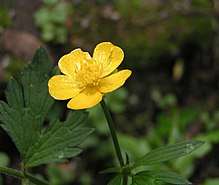Ranunculaceae
Ranunculaceae (buttercup or crowfoot family; Latin rānunculus "little frog", from rāna "frog") is a family of over 2,000 known species of flowering plants in 43 genera,[2] distributed worldwide.
| Ranunculaceae | |
|---|---|
 | |
| Ranunculus auricomus | |
| Scientific classification | |
| Kingdom: | Plantae |
| Clade: | Tracheophytes |
| Clade: | Angiosperms |
| Clade: | Eudicots |
| Order: | Ranunculales |
| Family: | Ranunculaceae Juss. |
| Type genus | |
| Ranunculus | |
| Subfamilies | |
| |
The largest genera are Ranunculus (600 species), Delphinium (365), Thalictrum (330), Clematis (325), and Aconitum (300).
Description
Ranunculaceae are mostly herbaceous annuals or perennials, but some woody climbers (such as Clematis)[3] or shrubs (e.g. Xanthorhiza).
Most members of the family have bisexual flowers which can be showy or inconspicuous. Flowers are solitary, but are also found aggregated in cymes, panicles, or spikes. The flowers are usually radially symmetrical but are also found to be bilaterally symmetrical in the genera Aconitum and Delphinium.[4][5] The sepals, petals, stamens and carpels are all generally free (not fused), the outer flower segments typically number four or five. The outer stamens may be modified to produce only nectar, as in Helleborus and Delphinium.[5] In some genera, such as Thalictrum the sepals are colorful and appear petal-like and the petals can be inconspicuous or absent.[3] The stems are unarmed. The leaves are variable. Most species have both basal and cauline (stem) leaves, which are usually compound or lobed but can be simple. They are typically alternate, or occasionally opposite or even whorled. Many species, especially the perennials form rhizomes that develop new roots each year.[6] Ficaria verna can reproduce vegetatively by means of root tubers produced in the leaf axils.[3][4] Some members of the genus Thalictrum utilize anemophily while others utilize entomophily.[7] Flowers of the entomophilous genus Papaver, also of the Ranunculales order, produce only pollen.[8] Until recently, it was believed that the species of the genus Anemone also lack nectar.[9]
The fruits are most commonly free, unfused achenes (e.g. Ranunculus, Clematis) or follicles (e.g. Helleborus, Eranthis, Nigella), but a berry in Actaea.[3][4]
Ranunculaceae contain protoanemonin, which is toxic to humans and animals. Other poisonous or toxic compounds, alkaloids and glycosides, are also common.
Taxonomy
Takhtajan (1997) included the Ranunculaceae as the only family in the Ranunculales which he placed in a subclass, the Ranunculidae, instead of a superorder. Previously, Thorn (1992) placed the Ranunculaceae in the Berberidales, an order within the Superorder Magnolianae. Earlier Cronquist in 1981 included the Ranunculaceae along with seven other families in the Rancunculales which was included in the Magnoliidae, which he regarded as a subclass.[10] David, (2010)[11] placed the Ranuculaceae, together with the Eupteleaceae, Lardizabalaceae, Menispermaceae, Berberidaceae, and Papaveraceae in the Ranunculales, the only order in the superorder Ranunculanae. This follows the work of the Angiosperm Phylogeny Group.
The family Ranunculaceae sensu stricto (APG) is one of seven families included in the order Ranunculales within the eudicots according to the Angiosperm Phylogeny Group classification.[12] The family is monophyletic with Glaucidium as sister to the remaining genera.[13] This phylogeny is illustrated in the APG Poster.[14]
Subdivision
Early subdivisions of the family, such as Michel Adanson (1763), simply divided it based on one-seeded or many-seeded fruit. Prantl (1887) envisaged three tribes, Paeonieae, Hellebroreae and Anemoneae with Paeonia, Glaucidium and Hydrastis forming Paeonieae. By the twentieth century Langlet (1932) used chromosome types to create two subfamilies, Ranunculoideae and Thalictroideae. In 1966 Tamura further developed Langlet's system by adding floral characteristics with six subfamilies;
- Helleboroideae
- Ranunculoideae
- Isopyroideae
- Thalictroideae
- Coptidoideae
- Hydrastidoideae
but by 1988 he had reduced Coptidoideae to a tribe within Isopyroideae, leaving five subfamilies, an arrangement he continued in his 1993 monograph, dividing the larger subfamilies into tribes, though by then Paeonia and Glaucidium were no longer considered to belong to Ranunculaceae.[15] Paeonia was separated from Ranuculaceae and placed in its own family of Paeoniaceae (order Saxifragales). other genera originally included in Ranunculaceae include Circaeaster which was placed in its own family Circaeasteraceae.
Tamura's complete system was structured as follows;
- Subfamilies and tribes
- Subfamily Ranunculoideae Hutch.
- Adonideae Kunth
- Anemoneae DC.
- Ranunculeae DC.
- Subfamily Helleboroideae Hutch.
- Helleboreae DC.
- Cimicifugeae Torrey & A.Gray
- Delphineae Schrödinger
- Nigelleae Schrödinger
- Subfamily Isopyroideae Tamura
- Coptideae Langlet ex Tamura & K.Kosuge
- Dichocarpeae Tamura & K.Kosuge
- Isopyreae Schrödinger
- Subfamily Thalictroideae
- Subfamily Hydrastidoideae
The genus Glaucidium, having been moved to its own family (Glaucidiaceae), has since been restored to Ranuculaceae.
Molecular phylogenetics
When subjected to molecular phylogenetic analysis only Thalictroideae is monophyletic. The position of Glaucidium and some of its unique morphological characteristics prompted Stevens to suggest that it be given subfamilial rank as the monotypic Glaucidioideae. Similarly Hydrastis has been assigned to subfamily Hydrastidoideae.[16][13] Both genera are represented by a single species, Glaucidium palmatum and Hydrastis canadense respectively.
The relationships between the genera suggest the existence of three major clades corresponding to Coptidoideae, Thalictroideae (clade A) and Ranunculoideae (clade F). The latter is the largest with four subclades (B–E). Of these C corresponds to Delphineae, D to Cimicifugae and E to Ranunculoideae.[13] Consequently, Wang and colleagues (2009) proposed a new classification with five subfamilies, and further subdividing Ranunculoideae into ten tribes. The relationship between the subfamilies is shown in the cladogram;
In addition to the two monotypic subgenera, Coptoideae has 17 species and Thalictroideae has 450, including Thalictrum and Aquilegia. The other genera (2025 species, 81% of the family) belong to Ranunculoideae. Kingdonia had been included by Tamura in Anemoneae, but is now added to Circaeasteraceae.
- Subfamilies of Ranunculaceae (5) and tribes of Ranunculoideae
- Glaucidioideae (Tamura) Loconte (1)
- Hydrastidoideae Engler (1)
- Coptidoideae Tamura (2)
- Thalictroideae Raf. (10)
- Ranunculoideae Arn. (46)
- Adonideae Kunth
- Delphinieae Schröd.
- Nigelleae Schröd.
- Helleboreae DC.
- Cimicifugeae Torr.and A.Gray
- Caltheae Bercht .and J.Presl
- Asteropyreae W.T.Wang and C. Y.Chang
- Callianthemeae W.Wang and Z. D.Chen
- Anemoneae DC.
- Ranunculeae DC.
| Cladogram of Ranunculaceae subfamilies[13] | |||||||||||||||||||||||||||
|
Genera
Ranunculaceae contains approximately 43 genera.[2][17]
- Subfamily Glaucidioideae
- Glaucidium Siebold & Zuccarini
- Subfamily Hydrastidoideae
- Hydrastis L.
- Subfamily Coptidoideae
- Coptis Salisb.
- Xanthorhiza Marshall
- Subfamily Thalictroideae
- Aquilegia L.
- Dichocarpum W.T.Wang & P.K.Hsiao
- Enemion Rafinesque
- Isopyrum L.
- Leptopyrum Reichenbach
- Paraquilegia J.R.Drumm. & Hutch.
- Paropyrum Ulbr.
- Semiaquilegia Makino
- Thalictrum L.
- Urophysa Ulbr.
- Subfamily Ranunculoideae
- Tribe Adonideae
- Tribe Delphinieae
- Aconitum L.
- Consolida Gray
- Delphinium L.
- Tribe Nigelleae
- Nigella L.
- Tribe Helleboreae
- Helleborus L.
- Tribe Cimicifugeae
- Actaea L.
- Anemonopsis Siebold & Zuccarini
- Beesia Balf.f. & W.W.Sm.
- Cimicifuga Wernisch.
- Eranthis Salisb.
- Souliea Franch.
- Tribe Caltheae
- Caltha L.
- Tribe Asteropyreae
- Asteropyrum J.R.Drumm. & Hutch.
- Tribe Callianthemeae
- Callianthemum C.A.Mey.
- Tribe Anemoneae
- Anemoclema (Franch.) W.T.Wang
- Anemone L.
- Clematis L.
- Hepatica Mill.
- Naravelia Adans.
- Pulsatilla Mill.
- Tribe Ranunculeae
- Barneoudia Gay
- Calathodes Hook.f. & Thomson
- Callianthemoides Tamura
- Ceratocephala Moench
- Ficaria Guett.
- Halerpestes Greene
- Hamadryas Comm. ex Juss.
- Knowltonia Salisb.
- Krapfia DC.
- Laccopetalum Ulbr.
- Metanemone W.T.Wang
- Miyakea Miyabe & Tatew.
- Myosurus L.
- Oreithales Schltdl.
- Oxygraphis Bunge
- Paroxygraphis W.W.Sm.
- Ranunculus L.
- Trautvetteria Fisch. & C.A.Mey.
Previous genera
- Anemonella Spach → Thalictrum
- Psychrophila (DC.) Bercht. & J.Presl → Caltha
Fossil record
Fossils of fruits, pollen, seeds, and leaves are known from several dozen locations. The fossil record begins in the early Cretaceous and continues throughout the Tertiary. In most cases, the fossils are assigned to extant genera, or show a close relationship to a particular extant genus.[1]
Uses
Some Ranunculaceae are used as herbal medicines because of their alkaloids and glycosides, such as Hydrastis canadensis (goldenseal), whose root is used as a tonic. More than 30 species are used in homeopathy, including Aconitum napellus, Cimicifuga racemosa, Clematis recta, Clematis virginiana, Hydrastis canadensis, Ranunculus bulbosus, Helleborus niger, Delphinium staphisagria, Pulsatilla nigricans. Many genera are well known as cultivated flowers, such as Aconitum (monkshood), Clematis, Consolida (larkspur), Delphinium, Helleborus (Christmas rose), Trollius (globeflower). The seeds of Nigella sativa are used as a spice in Indian and Middle Eastern cuisine.[18]
Gallery
Tribes of subfamily Ranunculoideae
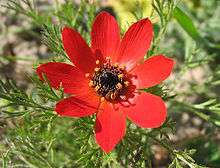 Adonideae:
Adonideae:
Adonis annua Delphinieae:
Delphinieae:
Delphinium elatum hybrid Nigelleae:
Nigelleae:
Nigella damascena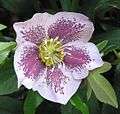 Helleboreae:
Helleboreae:
Helleborus × hybridus Cimicifugeae:
Cimicifugeae:
Cimicifuga simplex Caltheae:
Caltheae:
Caltha palustris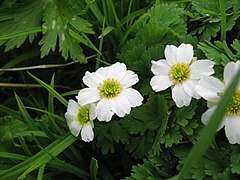 Callianthemeae:
Callianthemeae:
Callianthemum hondoense Anemoneae:
Anemoneae:
Anemone nemorosa Ranunculeae:
Ranunculeae:
Ranunculus auricomus
Other subfamilies
- Coptidoideae:
Coptis trifolia - Glaucidioideae:
Glaucidium palmatum 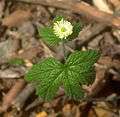 Hydrastidoideae:
Hydrastidoideae:
Hydrastis canadensis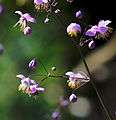 Thalictroideae:
Thalictroideae:
Thalictrum delavayi Thalictroideae:
Thalictroideae:
Aquilegia vulgaris Thalictroideae:
Thalictroideae:
Isopyrum thalictroides
See also
- List of Anemone species
References
- Pigg & DeVore 2005.
- Christenhusz & Byng 2016.
- Clapham, Tutin & Warburg 1981.
- Stace 2010.
- Ronse de Craene 2010.
- FNA 2008
- Steven, Janet; Waller, Donald (2004). "Reproductive alternatives to insect pollination in four species of Thalictrum (Ranunculaceae)". Plant Species Biology. 19 (2): 73–80. doi:10.1111/j.1442-1984.2004.00103.x. Retrieved 6 December 2018.
- Ross, Gary (22 December 2016). "Treat Your Bees to a Banquet of Poppies". Bee Culture. A.I. Root Company. Retrieved 6 December 2018.
- Erbar, Claudia; Leins, Peter (2013). "Nectar production in the pollen flower of Anemone nemorosa in comparison with other Ranunculaceae and Magnolia (Magnoliaceae)". Organisms Diversity & Evolution. 13 (3): 287–300. doi:10.1007/s13127-013-0131-9. Retrieved 6 December 2018.
- Flowering Plant Gateway
- "Plants in their proper places – the new classification of flowering plants" (PDF). Royal Horticultural Society. Archived from the original (PDF) on 18 July 2011.
- APG 2016.
- Wang et al 2009.
- Angiosperm Phylogeny Poster
- Tamura 1993.
- Stevens 2017.
- The Plant List 2013, Ranunculaceae
- Turner 1984.
Bibliography
- Clapham, A.R.; Tutin, T.G.; Warburg, E.F. (1981). Excursion flora of the British Isles (3 ed.). Cambridge, U.K.: Cambridge University Press. ISBN 978-0521232906.CS1 maint: ref=harv (link):25
- Stace, C. A. (2010). New Flora of the British Isles (3 ed.). Cambridge, U.K.: Cambridge University Press. ISBN 9780521707725.CS1 maint: ref=harv (link):101
- Ronse de Craene, L.P. (2010). Floral diagrams, an aid to understanding flower morphology and evolution. Cambridge University Press. ISBN 9780521729451.CS1 maint: ref=harv (link):140
- Christenhusz, M. J. M.; Byng, J. W. (2016). "The number of known plants species in the world and its annual increase". Phytotaxa. 261 (3): 201–217. doi:10.11646/phytotaxa.261.3.1.CS1 maint: ref=harv (link)
- Langlet, O. (1932). Uber Chromosomenverhaltnisse und Systematik der Ranunculaceae. Svensk Bot. Tidskr 26, 381–401.
- APG (2016). "An update of the Angiosperm Phylogeny Group classification for the orders and families of flowering plants: APG IV". Botanical Journal of the Linnean Society. 181 (1): 1–20. doi:10.1111/boj.12385.CS1 maint: ref=harv (link)
- Keener, Carl S.; Reveal, James L.; Dutton, Bryan E.; Ziman, Svetlana (August 1999). "A List of Suprageneric Names in Ranunculaceae (Magnoliophyta)". Taxon. 48 (3): 497. doi:10.2307/1224562. JSTOR 1224562.
- Kubitzki, Klaus; Rohwer, Jens G.; Bittrich, Volker, eds. (1993). The Families and Genera of Vascular Plants. II Flowering plants - Dicotyledons. Magnoliid, Hamamelid and Caryophyllid families. Berlin: Springer. ISBN 978-3540555094.
- Pigg, K. B.; DeVore, M. L. (1 October 2005). "Paleoactaea gen. nov. (Ranunculaceae) fruits from the Paleogene of North Dakota and the London Clay". American Journal of Botany. 92 (10): 1650–1659. doi:10.3732/ajb.92.10.1650. PMID 21646082.CS1 maint: ref=harv (link)
- Stevens, P.F. (2017) [2001], Angiosperm Phylogeny Website, Missouri Botanical Garden, retrieved 13 April 2015CS1 maint: ref=harv (link)
- Sandro Pignatti. Flora d'Italia, Edagricole, Bologna 1982.(in Italian) ISBN 88-506-2449-2
- Tamura, M (1993-07-28). Ranunculaceae. pp. 563–583. ISBN 9783540555094., in Kubitzki et al (1993)
- Strasburger, Noll, Schenck, Schimper: Lehrbuch der Botanik für Hochschulen. 4. Auflage, Gustav Fischer, Jena 1900, p. 459 (flower diagrams)
- Kumazawa, Masao (1938). "Systematic and Phylogenetic Consideration of the Ranunculaceae and Berberidaceae". Shokubutsugaku Zasshi. 52 (613): 9–15. doi:10.15281/jplantres1887.52.9.CS1 maint: ref=harv (link)
- Emadzade, Khatere; Lehnebach, Carlos; Lockhart, Peter; Elvira, Hörandl (June 2010). "A molecular phylogeny, morphology and classification of genera of Ranunculeae (Ranunculaceae)" (PDF). Taxon. 59 (3): 809–828. doi:10.1002/tax.593011.
- Wang, Wei; Lu, An-Ming; Ren, Yi; Endress, Mary E.; Chen, Zhi-Duan (January 2009). "Phylogeny and classification of Ranunculales: Evidence from four molecular loci and morphological data". Perspectives in Plant Ecology, Evolution and Systematics. 11 (2): 81–110. doi:10.1016/j.ppees.2009.01.001.
- Turner, NJ (July 1984). "Counter-irritant and other medicinal uses of plants in Ranunculaceae by native peoples in British Columbia and neighbouring areas". Journal of Ethnopharmacology. 11 (2): 181–201. doi:10.1016/0378-8741(84)90038-2. PMID 6387285.CS1 maint: ref=harv (link)
- Whittemore, Alan T.; Parfitt, Bruce D. (1997). "Ranunculaceae". In Flora of North America Editorial Committee (ed.). Flora of North America North of Mexico (FNA). 3. New York and Oxford – via eFloras.org, Missouri Botanical Garden, St. Louis, MO & Harvard University Herbaria, Cambridge, MA.
- The Plant List (2013). "The Plant List Version 1.1". Royal Botanic Gardens, Kew and Missouri Botanical Garden. Retrieved 7 July 2015.CS1 maint: ref=harv (link)
External links
- Flora of North America: Ranunculaceae
- Flora of China: Ranunculaceae
- Ranunculaceae in Topwalks
- Ranunculaceae in BoDD – Botanical Dermatology Database
- Ranunculaceae in L. Watson and M.J. Dallwitz (1992 onwards). The families of flowering plants.
- NCBI Taxonomy Browser
- links at CSDL, Texas
- Japanese Ranunculaceae - Flavon's art gallery
- Family Ranunculaceae Flowers in Israel
- Cai et al. Molecular phylogeny of Ranunculaceae based on internal transcribed spacer sequences 2009
- Aconitum heterophyllum (fam. Ranunculaceae) at the Encyclopedia of Ayurvedic Medicinal Plants
| Wikimedia Commons has media related to Ranunculaceae. |
| Wikispecies has information related to Ranunculaceae |
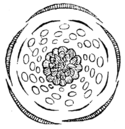

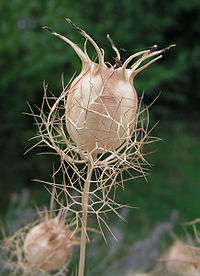
.jpg)

